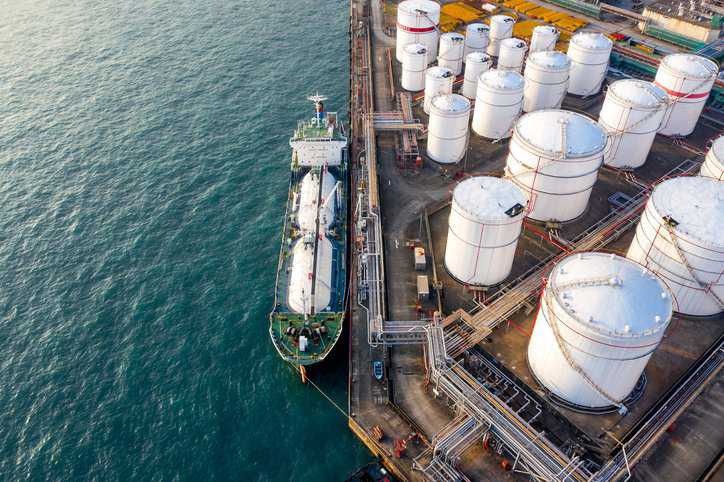Cargo ships carry over 90% of global goods. They are typically are powered by heavy fuel oil (HFO)—a residual fuel produced from petroleum refining that emits large amounts of greenhouse gasses (GHGs) when combusted. Sustainable marine fuels produce lower GHG emissions compared to HFO and other petroleum-based marine fuels. Consequently, examining ways the maritime sector of transportation can utilize sustainable fuels is essential to reach the EU’s goal of becoming a climate neutral economy by 2050. ISO 8217:2024— Products From Petroleum, Synthetic And Renewable Sources – Fuels (Class F) – Specifications Of Marine Fuels provides specifications for fuels used in marine applications.
Sustainability of Marine Fuels
International maritime transport accounts for approximately 3% of global greenhouse gases. This includes a wide variety of vessels, from small recreational boats to massive, ocean-going container ships. There is a shift away from marine fuels supplied from traditional oil products toward those derived from synthetic and renewable, recycled, or alternative sources.
With a far lower carbon footprint than petroleum-based fuels, sustainable marine fuels are critical for lowering GHG emissions, achieving environmental justice, and promoting energy security in the maritime sector. As such, ISO 8217:2024 takes into consideration the diverse nature of these fuels and incorporates a number of categories of distillate and residual fuels. The standard also considers environmental legislation and allows marine fuels to include not only hydrocarbons from petroleum crude oil, oil sands, and shale oil but also hydrocarbons from synthetic or renewable sources and allows some grades to contain fatty acid methyl esters (FAME).
What Is ISO 8217?
ISO 8217:2024 defines the general requirements and specifications for fuels used in marine diesel engines and boilers, prior to onboard fuel handling (storage, settling, centrifuging, filtration, heating). For the purposes of this document, the term “fuels” comprises of the following:
- Hydrocarbons from petroleum crude oil, oil sands, and shale oil
- Synthetic hydrocarbons, renewable hydrocarbons or hydrocarbons from recycled sources, with molecular structures that are indistinguishable from petroleum hydrocarbons
- Fatty acid methyl ester (FAME), where permitted as specified in this document
- Blends of any of the above, where permitted as specified in this document
The general requirements and specifications for fuels in ISO 8217:2024 can also be applied to fuels used in stationary diesel engines of the same or similar type as those used for marine purposes.
The international standard was prepared in cooperation with ship owners, ship operators, shipping associations, national standards bodies, classification societies, fuel testing services, engine designers, fuel treatment equipment manufacturers, marine fuel suppliers, fuel additive suppliers, and the petroleum industry to meet the requirements for marine fuels supplied on a world-wide basis for consumption on board ships.
How Are Hydrocarbons Used As Fuel?
Hydrocarbons are organic, naturally-occurring compounds consisting of hydrogen and carbon that are mainly used as a combustible fuel source. They are the primary component of fossil fuels like coal, natural gas, and petroleum, which are often called hydrocarbon resources. When burned, or combusted, hydrocarbons react with oxygen to produce heat, energy, carbon dioxide, and water vapor. As such, hydrocarbons are highly effective as a source of fuel and are used to power many things, including cars, lights, home heating, and boats.
Changes from the 2017 Edition of ISO 8217
ISO 8217:2024 cancels and replaces the prior edition (ISO 8217:2017), which has been technically revised in terms of its structure and distillate fuel specifications:
The Main Technical Changes in ISO 8217:2024:
- Terms and definitions (Clause 3) have been updated
- The Scope and the general requirements in Clause 5, “General requirements,” have been amended, and Tables 2, “Residual marine fuels with sulfur content below or at 0,50 % by mass,” and 3, “Bio-residual marine fuels,” have been added
- Former Table 2 has been modified and has become Table 4, “Residual marine fuels with sulfur content above 0,50 % by mass”
- New Annexes F, “Cold flow characteristics,” H, “Stability of residual fuels,” and K, “Characterization of residual marine fuels,” have been added (the former Annex F has become Annex G, the former Annex G has become Annex I, and the former Annex H has become Annex J)
- Existing annexes have been reviewed and updated
Changes to the Distillate Fuels in ISO 8217:2024:
- The requirement to report the fatty acid methyl ester(s) content (FAME) of DF grades has been changed, allowing up to 100 %
- The distinction between winter and summer quality for cloud point and cold filter plugging point has been removed
- The requirement to report the net heat of combustion for DF grades has been added
- A minimum cetane number requirement for DF grades has been added
- The requirement for oxidation stability for DF grades has been added
- Clauses 9, “Requirements for marine fuel consisting of 100 % FAME or paraffinic diesel fuel,” and 10, “Generally applicable requirements and related test methods” have been added
ISO 8217:2024— Products From Petroleum, Synthetic And Renewable Sources – Fuels (Class F) – Specifications Of Marine Fuels is available on the ANSI Webstore.
